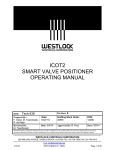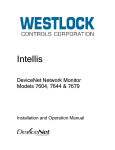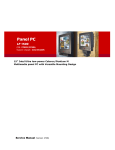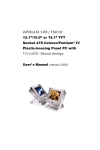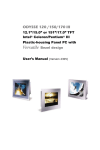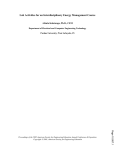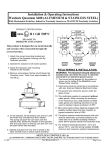Download Westlock Controls Corporation Beacon Specifications
Transcript
QUANTUM ROTARY MODELS: 764/864/765/865/784/789/711/811 722/777/877/360/366 INSTALLATION AND OPERATIONS MANUAL IOM: Tech-382 Prepared By: Herb Tucker Date: 8/23/05 Revision: A Reviewed By: Lee Bradley Approved By: Rhonda Frey Date: 3/25/13 Drafting Work Order:20285 ECN: 12261 Date: 3/25/13 This IOM contains confidential information and is issued in confidence on the condition that it be returned on demand and not be copied, reproduced, disclosed to others or used in manufacture of the subject matter thereof without the written consent of Westlock Controls WESTLOCK CONTROLS CORPORATION 280 N. MIDLAND AVE., STE. 258, SADDLE BROOK, NJ 07663 TEL: 201-794-7650 FAX: 201-794-0913 westlockcontrols.com 4/7/10 TECH-382/D.W.O. 17072 Page 1 of 15 Revision History Revision Initial release 8/23/05: Rev. A 3-25-13 Westlock Controls Offices USA Westlock Controls Corp. 280 North Midland Ave. Ste 258, Saddle Brook, NJ 07663 Phone: (201) 794-7650 •Fax: (201) 794-0913 Email: [email protected] Internet http://westlockcontrols.com Europe Westlock Controls UK Chapman Way, Tunbridge Wells Kent, England TN23EF Phone: 011-44-189-251-6277 •Fax: 011-44-189-251-6279 Email: [email protected] Internet: http://westlockcontrols.com South America Westlock Equipamentos de Controle Ltda. Operations: Sales: Av. Antonio Bardella, 3000 Al. Araguaia, 2044 – Sl. 1101, Bloco B Galpões 2A e 2B – Alto da Boa Vista Edifício CEA – Alphaville Sorocaba – São Paulo – Brazil Barueri – São Paulo – Brazil 18085-852 06455-000 Tel: + 55 15 2102-7400 Tel: + 55 11 2588-1400 Fax: + 55 15 2102-7400 Fax: + 55 11 2588-1410 Email: [email protected] Internet: http://westlockcontrols.com WESTLOCK CONTROLS CORPORATION 280 N. MIDLAND AVE., STE. 258, SADDLE BROOK, NJ 07663 TEL: 201-794-7650 FAX: 201-794-0913 westlockcontrols.com 4/7/10 TECH-382/D.W.O. 17072 Page 2 of 15 1. Introduction 1.1. Product Certification 764/864/784: Type 4/4X for Non-Hazardous Locations Only 765/865/789: Non-incendive, Class I, Div. 2 Grps A, B, C, D; Class II, Div. 2 Grps F,G; Type 4/4X 711/811/722: Intrinsically Safe, Class I, Div. 1 & 2 Grps A, B, C, D; Class II, T6, Ta=60 C, Div. 1 & 2 Grps E, F,G when operated through approved barriers; Type 4X. Max Entity Parameters for VA-30061 & VA-30217: Vmax=35V, Imax=300mA, Ci=0, Li=0; Installed in accordance with MS-10312. Max Entity Parameters for VA-30657-002 & VA-30658-002: Vmax=28V, Imax=115mA, Pi=1.6W, Ci=0, Li=0; Installed in accordance with WD-12031. 777/877: Class 1, Div. 1 & 2 Grps C, D; Class II, Grps E, F, G T6 Ta=60 C 360/366: Class 1, Div. 1 & 2 Grps C, D; Class II, Grps E, F, G T5 Ta=-50 C to 60 C, Type 4, 4X, 6P 1.2. Warnings Never remove enclosure cover or make/break electrical connections with power connected to the unit. Perform all wiring in accordance with site and local codes and the National Electric Code ANSI-NFPA-70 (US) or the Canadian Electric Code Part I (Canada) for the appropriate area classifications. Confirm that the Quantum model being installed is approved for the hazardous area (consult unit identification label). Ensure that approved and properly sized IS barriers are used in installations with 711, 811, 722 and 822 (confirm entity parameters from product ID label). Confirm that power supplied to switches and solenoid is within rated specifications listed on the unit identification label. Protect the unit from exposure to aggressive substances or atmospheres to ensure that hazard rating is not compromised. Disconnect power to solenoids and the inlet air supply before conducting any valve service or maintenance. Avoid the introduction of any contaminants into the valve. 1.3. Description Quantum valve control monitors are intended for use as both visual and electrical position indicators and controllers for discrete rotary devices, most commonly pneumatically actuated 2-way quarter-turn or 3-way valves. A Quantum control monitor is not limited for use in only quarter-turn valve applications, but that application will be assumed for the purpose of this document. In addition to the control monitoring features, Quantum control monitors may serve as wiring junctions for accessories where additional WESTLOCK CONTROLS CORPORATION 280 N. MIDLAND AVE., STE. 258, SADDLE BROOK, NJ 07663 TEL: 201-794-7650 FAX: 201-794-0913 westlockcontrols.com 4/7/10 TECH-382/D.W.O. 17072 Page 3 of 15 terminals, conduit entries and wiring codes permit. The Falcon integral solenoid valve is an air piloted solenoid valve system incorporating elastomer static seals through which a shaped spool moves and are manufactured for 3or 4-way operation. 3-way is normally used for pilot control of the other relay valves or for the operation of single acting cylinders. 4-way is normally used to control the action of double acting cylinders. 1.4. Principles of Operation A Quantum control monitor mounts to an actuator via a mounting kit, usually sold separately. The unit shaft couples to the actuator shaft directly via NAMUR adaptation, or via a coupling provided in the mounting kit. The Quantum’s integral Falcon solenoid-piloted directional control valve provides an air signal to the actuator to change its state, thus controlling the actuated valve. An electrical signal from the control system actuates the integral solenoid valve system in the Quantum. In a typical, normally closed, springreturn Falcon valve, the spool controlling the direction of air flow is moved by pressurized pilot air acting on a piston when the coil is energized. The spool is returned to the normally closed position by a spring, and the piston is vented to atmosphere. The spool may be manually moved to control air flow direction with override options. The pilot air supply is normally routed internally from the air supplied to Inlet port 1. Power is supplied separately to pre-wired coils via the terminal strip in the Quantum. As the actuator rotates the unit shaft, adjustable cams on the shaft actuate mechanical or proximity switches inside the unit enclosure, at the limits of rotary travel set by the customer. The switches are pre-wired to the terminal strip in the enclosure, permitting easy connection of switch output to external electrical control monitoring systems or indication devices. The visual Beacon indicator on the enclosure cover indicates 90 rotary travel between OPEN and CLOSED valve positions, unless ordered optionally for other angular strokes or 3-way valve applications. 1.5. Special Features/Conditions To avoid build-up and discharge of static electricity in a hazardous area, only clean Westlock units with a static-free cloth dampened with water. Avoid the use of alcohol-based cleaners. 2. Ordering Ordering guides for all Quantum product series and spare Falcon valve assemblies and stand-alone valves for use outside an integrated Westlock Controls monitor covered by this IOM are available through a local Westlock distributor, the current Westlock Controls catalog literature or the Westlock Controls website at westlockcontrols.com. Spare parts lists for refurbishments or repairs are also available for common Quantum models. WESTLOCK CONTROLS CORPORATION 280 N. MIDLAND AVE., STE. 258, SADDLE BROOK, NJ 07663 TEL: 201-794-7650 FAX: 201-794-0913 westlockcontrols.com 4/7/10 TECH-382/D.W.O. 17072 Page 4 of 15 3. Definitions NAMUR- This term, in the context of mounting brackets and shafts, refers to the NAMUR VDI/VDE 3845 standard for the dimensions of actuator output shafts and auxiliary equipment mounting hole patterns. In the context of inductive proximity sensors, NAMUR refers to conformance of the sensor to DIN 19 234, allowing its use with any NAMUR style amplifier/isolator. Switch- A manual or mechanically actuated device for making, breaking or changing the connections in an electric circuit. This term will be used also for magnetic or inductive proximity sensors for the purpose of this document. 4. 4.1. Installation Mounting Instructions Required Tools: Open-end wrenches or adjustable wrench to fit all sizes of hex head bolts in the mounting kit. 1. Obtain a mounting kit suited for the actuator/valve, commonly available through a local Westlock Controls distributor. 2. Attach the mounting bracket and coupler (if required) to the unit housing with the hardware provided. 3. Attach the unit and mounting system to the actuator. 4. Ensure proper axial alignment between unit shaft, coupler and actuator shaft. Failure to ensure alignment could result in long-term stressrelated failure of unit shaft in high cycle or high torque applications. Fig. 1 Mounting the Quantum units with accessory bracket kits WESTLOCK CONTROLS CORPORATION 280 N. MIDLAND AVE., STE. 258, SADDLE BROOK, NJ 07663 TEL: 201-794-7650 FAX: 201-794-0913 westlockcontrols.com 4/7/10 TECH-382/D.W.O. 17072 Page 5 of 15 4.2. Solenoid Valve Operating Instructions 4.2.1 Standard Valve Specifications NOTE: ALWAYS consult the Quantum product ID label for coil electrical specifications and for pressure and temperature specifications for each unit, as they will vary with area classification, valve options and other factors. Std. Operating Pressure: 45-120 PSIG Std. Operating Temperature: -4° F to 176° F (Agency approvals may be valid for different operating temperature ranges). Operating Media: Lubricated or dry air, filtered to 20 microns. 4.2.2 Installation/Connection of Falcon Directional Control Valve Porting Designation 1/4” NPT air ports for inlet, outlet, and exhaust (3.5 Cv valve has 1/2” NPT air ports) Spring Return 4-way (5/2) Valve Description of Operation: Solenoid De-energized air flows from Inlet Port 1 to Outlet Port 2 and exhausts from Port 4 to Port 5. Solenoid Energized air flows from Inlet Port 1 to Outlet Port 4 and exhausts from Port 2 to Port 3. Spring Return 3-Way (3/2) Valve Description of Operation: Solenoid De-energized air flows from Outlet Port 2 to Exhaust Port 3. Solenoid Energized - air flows from Inlet Port 1 to Outlet Port 2. Dual Coil 4-way (5/2) Valve Description of Operation: Coil B Energized air flows from Inlet Port 1 to Outlet Port 2 and exhausts from Port 4 to Port 5. Coil A Energized air flows from Inlet Port 1 to Outlet Port 4 and exhausts from Port 2 to Port 3. Fig. 2 Air Flow Diagrams Note: The valve will not change state until the energized coil is de-energized and the opposite coil is energized in that order. WESTLOCK CONTROLS CORPORATION 280 N. MIDLAND AVE., STE. 258, SADDLE BROOK, NJ 07663 TEL: 201-794-7650 FAX: 201-794-0913 westlockcontrols.com 4/7/10 TECH-382/D.W.O. 17072 Page 6 of 15 4.2.3 Usage Instructions for Option Valves Fig. 3 Fig. 4 Fig. 5 N - No-Voltage Release (Latching) Push palm button to shift valve completely and latch by depressing small button underneath the valve with finger. Open position will be sustained and latch will automatically disengage when air and voltage are applied. When the coil is de-energized, the valve will return to its original position. Available for 1.2Cv and 3.5Cv valves only (see Fig. 3). R - No-Voltage Release (Non-Latching) Energize coil and push palm button to manually shift valve. Valve will not shift unless the palm button is depressed but will remain shifted until coil is de-energized or air is lost. Available for 1.2Cv and 3.5Cv valves only (see Fig. 4). L - Locking Manual Override Push palm button and rotate clockwise to maintain shifted position until manually disengaged (see Fig. 5). Coils must be de-energized before operating manual override. M - Momentary Manual Override Push palm button and hold to maintain shifted position until button is released (see Fig. 5). Coils must be de-energized before operating manual override. E - External Pilot Provide auxiliary pressurized air supply to the external pilot connection of the valve. Supply a pressure signal (min. 45 psi) to this auxiliary port in conjunction with electrical signal to solenoid to shift the valve. This feature should be used when the pressure supplied to inlet port 1 is below the minimum 45 psi operating pressure. WESTLOCK CONTROLS CORPORATION 280 N. MIDLAND AVE., STE. 258, SADDLE BROOK, NJ 07663 TEL: 201-794-7650 FAX: 201-794-0913 westlockcontrols.com 4/7/10 TECH-382/D.W.O. 17072 Page 7 of 15 D/C - Dual Coil Option Four way valves are available with solenoid actuators on both ends of the Falcon valve, coil “A” and coil “B”, for fail-last logic. When only coil “A” is energized, the valve will shift as a standard 4-way does. If coil “A” is then deenergized, the valve will remain in this last position. The valve will not return to the original state until coil “A” is de-energized and coil “B” is energized. The process is the same for coil “B”. NOTES - For Dual Coil Valves 1. The valve may be in either position upon installation. Refer to the Air Flow Diagrams (Fig. 2) and energize the appropriate coil (with air) to reset valve to the desired position. 2. Dual coil valves require both an electrical signal and air pressure to operate. See Air Flow Diagram for air pressure requirements. If either or both inputs are lost the valve will remain in its current position. 3. Both coils should never be energized simultaneously. 4. If using overrides on a dual coil valve, the coils must be de-energized. 4.2.4. Plumbing and Air Supply Considerations Air mains and lines should be sized, routed and pitched properly to avoid excessive pressure loss (more than 10% of applied pressure at maximum flow), air flow restriction or condensed moisture at the point of usage. Proper filtration of air supply per specifications in section 4.2.1 is critical to prevent premature failure of solenoid valves. If lubricators are used in the air line, use appropriate oil distribution equipment and oil grades, such as ISO and UNI FD22. The performance and life of pneumatic valves may be affected by air supply conditioning methods. Regulation of inlet pressure to within specified limits is also critical to prevent excessive seal wear, failure by extrusion or leakage. In general, pipe fittings should not be assembled to a specific torque because the torque required for a reliable joint varies with thread quality, port and fitting materials, sealant and other factors. Fittings should not be over-tightened or distortion and, most likely, complete valve failure can result. The following general procedure should be followed: 1. Inspect port and connectors to ensure that the threads are free of dirt, burrs and excessive nicks. 2. Apply sealant/lubricant or Teflon tape to the male pipe threads. With any sealant or tape, the first one or two threads should be left uncovered and care must be taken to avoid the application of excessive sealant media to avoid system contamination. 3. Install connectors into ports and wrench tighten per the fitting manufacturer’s recommendation to achieve an air-tight joint. WESTLOCK CONTROLS CORPORATION 280 N. MIDLAND AVE., STE. 258, SADDLE BROOK, NJ 07663 TEL: 201-794-7650 FAX: 201-794-0913 westlockcontrols.com 4/7/10 TECH-382/D.W.O. 17072 Page 8 of 15 4.3. Calibration Consult factory or a Westlock distributor for setting procedures of units with six switches or four switches and transmitter. Note 1: Switch actuation can be confirmed using a signal detection device such as a multimeter or ohmmeter, set for “continuity”. Note 2: For NAMUR P+F NJ2-V3-N type sensors, use test meter, P+F model #1-1350 or equivalent to check sensor actuation and calibration. If the proper meter is not available, contact the factory for additional assistance with the test procedure. Note 3: Adjust cams by hand by pushing/pulling the cam against the shaft spring to disengage from the mating spline, rotating to adjust and re-engaging firmly onto spline. Required Tools: Signal detection device (see note 1); slotted screw drivers or Allen keys for cover screws (M4, M5, #10, 5/16 or M8 by model) Switch Adjustment (two switches): 1. Remove unit cover as follows: loosen (but do not remove) captive screws, rotate cover slightly to grip corners, pull firmly. DO NOT PRY COVER WITH TOOLS. 2. With valve in the closed position, adjust bottom cam until bottom switch (#2) actuates. 3. Stroke valve to the open position, adjust top cam until top switch (#1) actuates. 4. Cycle actuator several times to confirm proper switch indication at each end of stoke. Finely adjust cams if necessary. 5. Skip to Field Wiring section or replace unit cover, applying approximately 20 in-lbs of torque to cover screws. TOP CAM PUSH DOWN, TURN & RELEASE BOTTOM CAM LIFT UP, TURN & RELEASE MAGNUM & MAGPAC PROXIMITY SWITCH MECHANICAL SWITCH iNDUCTIVE PROXIMITY SENSOR WESTLOCK CONTROLS CORPORATION 280 N. MIDLAND AVE., STE. 258, SADDLE BROOK, NJ 07663 TEL: 201-794-7650 FAX: 201-794-0913 westlockcontrols.com 4/7/10 TECH-382/D.W.O. 17072 Page 9 of 15 Switch Adjustment (four switches, no CS transmitter): Follow steps as above for the calibration of two switches but adjust the first and third cams from the top for switches #1 and #2 and the second and fourth cams from the top for switches #3 and #4 (see illustration below). TOP & 3RD CAM PUSH DOWN, TURN & RELEASE 2ND & BOTTOM CAM LIFT UP, TURN & RELEASE MAGNUM PROXIMITY SWITCH MECHANICAL SWITCH iNDUCTIVE PROXIMITY SENSOR Transmitter setting (optional CS transmitter): For the calibration of optional current signal (CS) transmitter, see Westlock Controls Installation/Operations Manual TECH-301, available through your local sales representative or at westlockcontrols.com. Beacon Adjustment: Note: Skip this step if cover is flat or Beacon already displays the correct valve status. Required Tools: slotted screw driver for #12 screws. 1. For two-way OPEN/CLOSED: remove, rotate and re-fasten outer beacon to synchronize displayed position with valve position. 2. For three-way flow paths: remove, rotate and re-fasten outer beacon and/or inner beacon coupler to synchronize displayed flow path with valve/actuator flow path. OPEN Valve in Position OPEN OPEN CLOSED Valve in Position CLOSED CLOSED For the 360 and 366 models: Required Tools: set screw driver for M4 set screws and snap ring tool. 1. Remove shaft snap ring and inner beacon. 2. Disengage set screws from outer beacon, rotate and re-fasten outer and inner beacon to synchronize displayed position with valve position. WESTLOCK CONTROLS CORPORATION 280 N. MIDLAND AVE., STE. 258, SADDLE BROOK, NJ 07663 TEL: 201-794-7650 FAX: 201-794-0913 westlockcontrols.com 4/7/10 TECH-382/D.W.O. 17072 Page 10 of 15 5. Field Wiring See the warnings section of this document for important warnings pertaining to the wiring of Quantum units. Remove and replace cover before and after wiring, per instructions given in the Switch Adjustment section above. Required Tools: slotted screw drivers for terminal strip screws (#2), cover screws (M4, M5, #10 or 5/16 by model), and grounding screw (#8 or M5 by model); wire strippers as required for field wires; Allen key for M8 cover screws (777/877). 1. Wire the AccuTrak monitor strictly according to the wiring diagram on the inside of the enclosure cover. 2. Confirm that the ground wire is secure under the green grounding screw in the enclosure. 3. Seal all unused conduit entries as required with suitably certified plugs having an ingress protection rating of IP67 or better. 4. Ensure that only suitably certified cable glands are used, having an ingress protection rating of IP67 or better. 5. Ensure that the temperature rating of all field wiring meets the service temperature range of the application. 6. Maintenance and Repair Maintenance or repair of Westlock equipment must only be done by Westlock Controls or by qualified personnel that are knowledgeable about the installation of electromechanical equipment in hazardous areas. All parts needed for repairs or maintenance must be purchased through a Westlock Controls authorized distributor to maintain warrantee and to ensure the safety and compliance of the equipment. No routine maintenance of Westlock AccuTrak units is recommended when units are installed in environments for which they are designed. Severe environments may warrant regular replacement of field units every two to five years for maximum performance and safety. Troubleshooting Problem: No signal at the control device Check that power supply to the loop is functioning correctly and adequate to power all devices on the loop; Check that power being supplied to switches is within the rated specifications; Check wiring integrity immediately at the connection to the control device; Check field wiring coming into the AccuTrak terminal strip for proper connection and good wire preparation practices (approximately ¼” of insulation removed and all strands intact); Check that field wiring is no larger than 12AWG for proper fit in terminal strip and compliance with terminal strip rating; Check that wiring integrity is good between switches and terminal strip; WESTLOCK CONTROLS CORPORATION 280 N. MIDLAND AVE., STE. 258, SADDLE BROOK, NJ 07663 TEL: 201-794-7650 FAX: 201-794-0913 westlockcontrols.com 4/7/10 TECH-382/D.W.O. 17072 Page 11 of 15 Check that cams are set to trigger switches properly in each valve position (see Switch Adjustment section under installation); Use multimeter set for “continuity: to check for failed switch; observe continuity between common and normally open when triggered and between common normally closed when not triggered. Problem: Beacon does not display the correct flow path Reset Beacon per the Beacon Adjustment section under Calibration. Problem: Unit appears to be binding during valve stroke or unit shaft has broken Carefully measure and adjust axial alignment of unit shaft, coupler and actuator shaft to eliminate lifting or twisting of the coupler during travel. Problem: Unit has signs of moisture ingress Check torque on cover screws Check gaskets and sealing surfaces for debris and clean if necessary Check that conduit connections are properly sealed, including gland fittings and quick-disconnect receptacles Check that conduit pipes are properly pitched to direct condensing moisture away from units Check that all unused conduit entries are properly sealed with suitably certified plugs having an ingress protection rating of IP67 or better. Problem: Solenoid valve will not shift when energized. Check for sufficient pressure (45 psi min.) at solenoid valve inlet port #1 or at the external pilot port (if applicable) Check that only one solenoid coil is energized at a time for dual-coil solenoid valves Check that the valve is plumbed correctly: supply at #1, outlets at #2 and #4, exhausts at #3 and #5. WESTLOCK CONTROLS CORPORATION 280 N. MIDLAND AVE., STE. 258, SADDLE BROOK, NJ 07663 TEL: 201-794-7650 FAX: 201-794-0913 westlockcontrols.com 4/7/10 TECH-382/D.W.O. 17072 Page 12 of 15 7. Appendix A Wiring Diagram WESTLOCK CONTROLS CORPORATION 280 N. MIDLAND AVE., STE. 258, SADDLE BROOK, NJ 07663 TEL: 201-794-7650 FAX: 201-794-0913 westlockcontrols.com 4/7/10 TECH-382/D.W.O. 17072 Page 13 of 15 Appendix B Installation Drawing WESTLOCK CONTROLS CORPORATION 280 N. MIDLAND AVE., STE. 258, SADDLE BROOK, NJ 07663 TEL: 201-794-7650 FAX: 201-794-0913 westlockcontrols.com 4/7/10 TECH-382/D.W.O. 17072 Page 14 of 15 WESTLOCK CONTROLS CORPORATION 280 N. MIDLAND AVE., STE. 258, SADDLE BROOK, NJ 07663 TEL: 201-794-7650 FAX: 201-794-0913 westlockcontrols.com 4/7/10 TECH-382/D.W.O. 17072 Page 15 of 15















